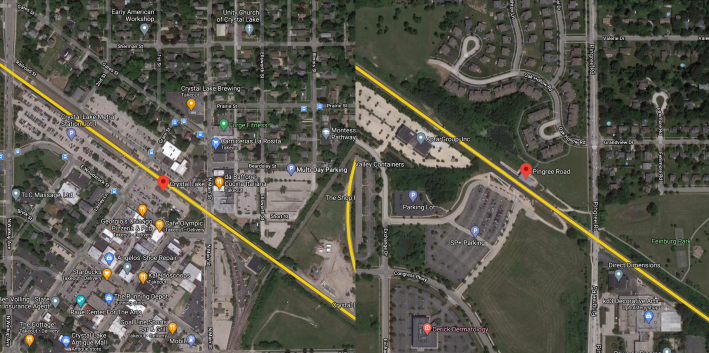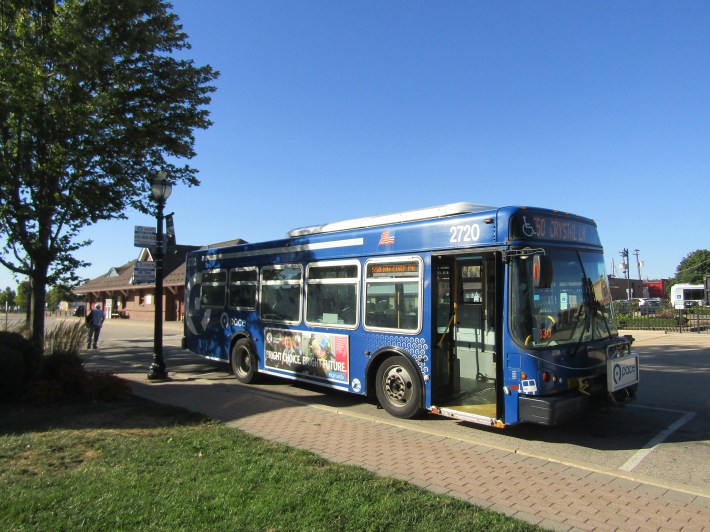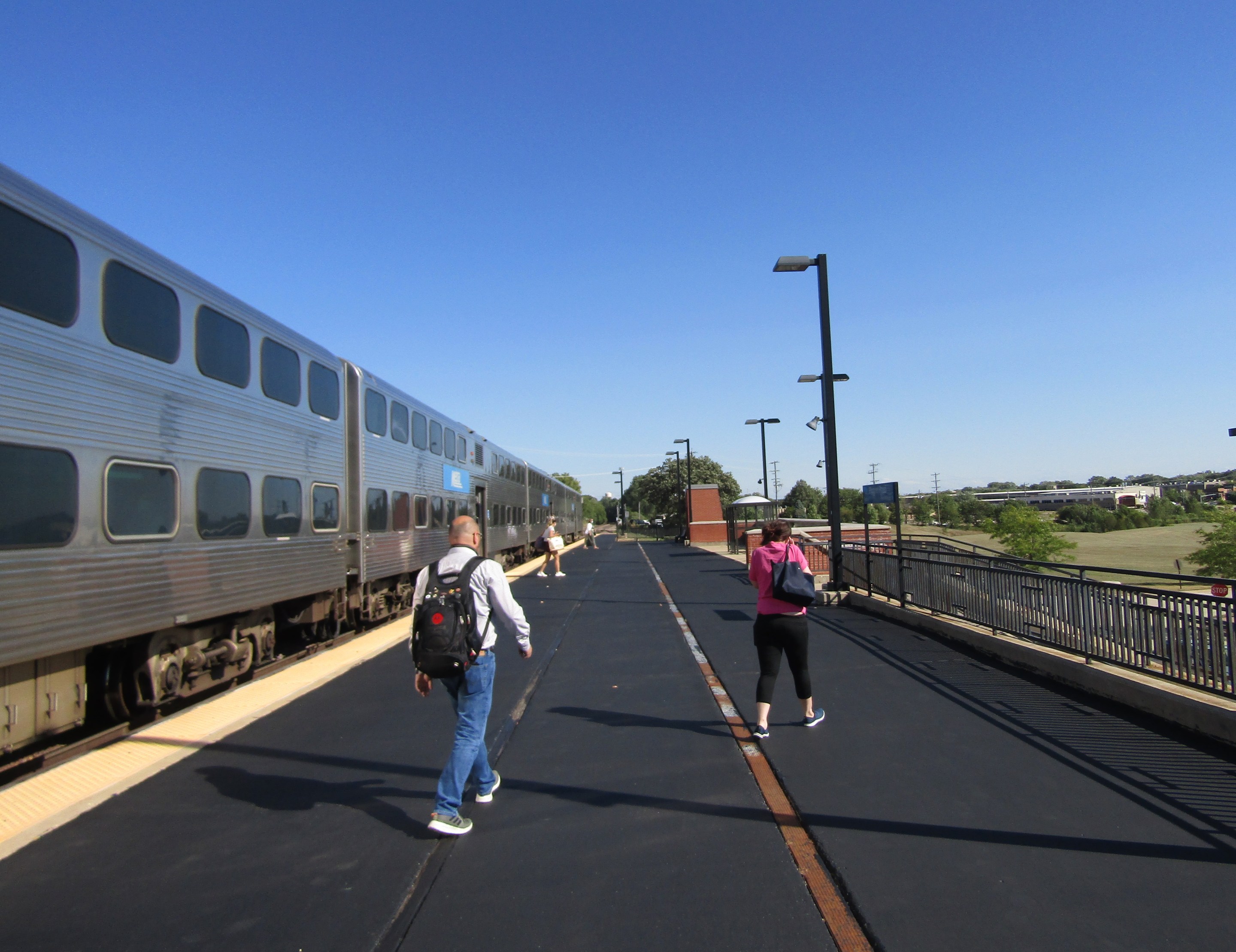Crystal Lake is working with the Regional Transportation Authority to create a Strategic Action Plan, which would guide community development and transportation planning around the city’s two Metra stations, located on the Union Pacific Northwest line.
The Far Northwest suburb, population 39,829, is located in McHenry County, the most rural of the six counties that make up the RTA service area, and the one with the least transit service. Crystal Lake is better off than much of the county in that regard, because it has two Metra stations and three bus routes. But while the downtown Crystal Lake station is a local transit hub, the Pingree Road station further southeast is more car-orientated.
The Crystal Lake and Pingree Road Stations Strategic Action Plan will serve as a blueprint for future development within about a quarter-mile radius around each station. The project is still in an early phase, with planners focusing on public outreach. While COVID-19 forced them to adjust their approach to collecting input, they are currently planning to hold an online kick-off in October and release the first draft of the plan sometime next summer.
Background
McHenry residents and officials have long complained that they are not getting their money’s worth for the RTA portion of the sales tax they’re paying, and with good reason. The entire county only has seven Metra stations, one of which is rush-hour only and two of which have more limited service. The county only has four Pace bus routes, none of which run on weekends, and one of which, Route 806, was on the chopping block before the pandemic put a pause on the cancellation plan, because the route serves the McHerny Hospital. And the four routes only connect the major cities, with the remainder of the county relying on McRide Dial-a-Ride service, which can vary quite a bit depending on the township. In short, any transit improvements in the county are a big deal.
Crystal Lake’s two Metra stations are an interesting study in contrasts. The station currently called “Crystal Lake” traces its roots to the area’s very first train station, and what eventually became downtown Crystal Lake grew around it. As a result, many restaurants, shops and government buildings are within walking distance of the station. Three of the four McHenry County bus routes - Route 550, Route 806 and Route 808 - stop in the park-n-ride behind the station house, and it’s one of the McRide’s regular pick-up/drop-off locations. By suburban standards, it's a very pedestrian- and transit-friendly layout. [During non-pandemic times, I'd recommend bringing your bike on Metra and cycling two miles from the station to The Breakers, a historic and atmospheric tiki-Chinese restaurant. - Ed]

Meanwhile, the Pingree Road station was built in 2005 with a different design philosophy. Large parking lots dominate the land south of the station, and, aside from the coffee shop inside the stationhouse, the closest retail is about a 10-minute walk south, at the distinctly car-orientated shopping plazas along Northwest Highway. None of the fixed route buses serve the Pingree Road stop, and while McRide does, there isn’t a clearly designated stop riders can look for. On the other hand, there is significantly more vacant land near Pingree Road station than near the downtown Crystal Lake station, so there are more opportunities to do transit-orientated development. And the station does have more bike racks than the downtown one.
Pingree Road station is the last stop before the Union Pacific Northwest line splits into Harvard and McHenry branches. Since the McHenry branch is rush-hour only, riders don’t have many opportunities to take advantage of that fact, but it might become more relevant if the service ever increases.
The January 2019 McHenry County Transit Plan made transit-related development recommendations. It encouraged municipalities to prioritize sidewalk construction near Metra stations and bus stops, putting senior living facilities, affordable housing developments and social service agencies near transit, and having those facilities contribute to the costs of dial-a-ride services. The plan doesn’t recommend adding any Pace bus routes near Pingree Road station, but one of its long-term recommendations is creating a new Pace route that would link together downtown Crystal Lake station and Pace’s I-90/Barrington Road Park-n-Ride, which would serve western portions of the city and the aforementioned Northwest Highway shopping corridor.

The Strategic Plan
According to the Strategic Action Plan website, the plan is meant to embody the community-supported vision of what the development around the station should look like. Land use, redevelopment of existing sites and transportation and accessibility improvements are major components. The plan will not only lay out a vision, but outline how to accomplish it.
The Strategic Action Plan will take cues from Crystal Lake’s Transportation Plan and Green Infrastructure Vision, as well as the aforementioned McHenry County Transit Plan. A steering committee is made up of city staff, RTA and Metra representatives and “a diverse mix of station area business and property owners, residents, bicycle advocates, and the members of the development community.”
Crystal Lake and the RTA contracted the Chicago-based Houseal Lavigne Associates to help with the planning process. Brandon Nolin, the company's senior project manager, said public outreach will be an important part of the planning process. Public input will be used to gather ideas and refine the plan.
“While we have our own professional insights and we’ve engaged staff and the steering committee, we really use the public to help ground truth our understanding and make sure the strategies we’re considering are responsive to the vision for the two station areas,” Nolin said. “Later on in the process, once we have a draft plan, we will be engaging the public to review draft recommendations and tell us if we got it right, or if we missed the mark in certain areas of the plan.”
Because of COVID-19, Houseal Lavigne had to rethink their outreach strategy and shift entirely online. “To get the input we need in a safe and responsible manner, we’ve shifted to virtual platforms for small focus group meetings and meetings with our Steering Committee,” Nolin said. “We’ve also been promoting the use of the project’s online engagement tools including a questionnaire and [Houseal Lavigne’s in-house map-based engagement platform] map.social.” Residents are also encouraged to fill out an online community survey.
After Houseal Lavigne holds the virtual kick-off event in October, the planners will spend the winter and spring on developing the first draft of the plan. While they originally planned to release the draft plan in May 2021, with COVID-19 complicating public outreach, they pushed back the deadline to next summer, so that they have more time for “upfront public engagement.”
Ultimately, Nolin said, it will be up to Crystal Lake to work with the RTA and make sure the development plan is actually carried out. “[Crystal Lake] will also play a role in encouraging the types of future development and reinvestment envisioned in the plan,” he said.




